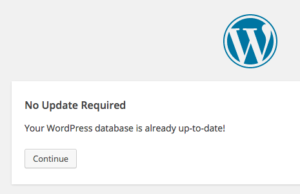The Issue
Sometimes after an automatic update you’ll be unable to access the wp-admin area. All attempts will redirect to an otherwise blank webpage that states, “Your WordPress database is already up-to-date. No update required.” There’s a “Continue” button, but it simply takes you to the front end (home page) of your site. Is your site stuck in this endless loop?

Solutions – How to fix WordPress “Database is already up to date” issue
I’ve seen numerous suggestions on how to resolve this issue. This problem is caused by site caching that, for some reason, runs into problems after an automatic WordPress update.
The following are the main solutions offered:
1. Try refreshing the browser cache. In my situation, this did not fix the issue, and I personally don’t think it will fix the problem in most cases. But it’s worth a try (some people reported it solved it for them). If you don’t know how to clear the browser cache, you can also just open a new Incognito browser window, and try accessing your site on there.
2. Log into your site over SSH (if you know how, and have SSH access), and then run the command `wp cache flush`, to flush the WordPress cache on the server. In my case, this also did not help.
3. An alternative way to delete the WP server cache is using FTP to create a new file, called `anything.php` (call it what you like, but ensure it has `.php` as the extension). Paste the following code into the file:
<?php include( './wp-load.php' ); wp_cache_flush();
Run the file once, and then be sure to delete it, or rename it by removing the PHP extension, So that it can’t be inadvertently executed.
4. WordPress Caching Plug-ins: Another suggestion is to delete or rename the object-cache.php file in the /wp-content folder. Search for any other cache related files. You might also find advanced-cache.php. You can just rename them to object-cache-disabled.php and advanced-cache-disabled.php. These files are generated by caching plug-ins such as W3 Total Cache, and WP Super Cache.
5. Host Specific Caching: In my case, this issue was caused by caching my hosting company provides for increased site speed. Specifically, it was caused by Memcached, which SiteGround makes available on their hosting packages. I saw people mention that DreamHost also have Memcached on their servers.
In the case of SiteGround, you can log into your CPanel, and click on the SuperCacher icon. Click on the “Level 3: Memcached” tab, and client the green “Flush Cache” button.
Hopefully one of those solutions works for you. If not, and you’d like assistance with the issue, feel free to ask us for tech support. If you’re not already a client of Inspired Earth, we can set you up for top-notch WordPress support in a few minutes.